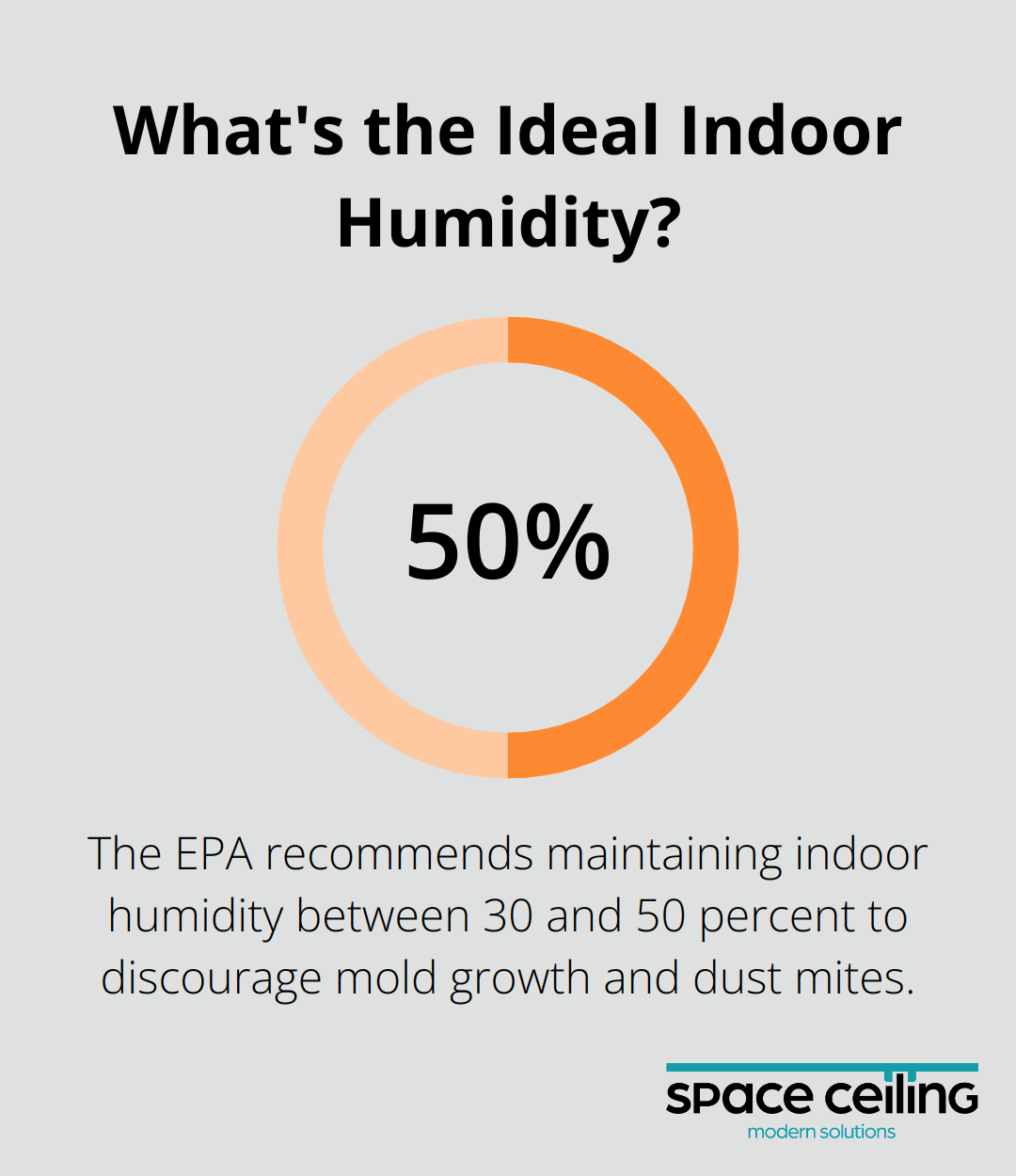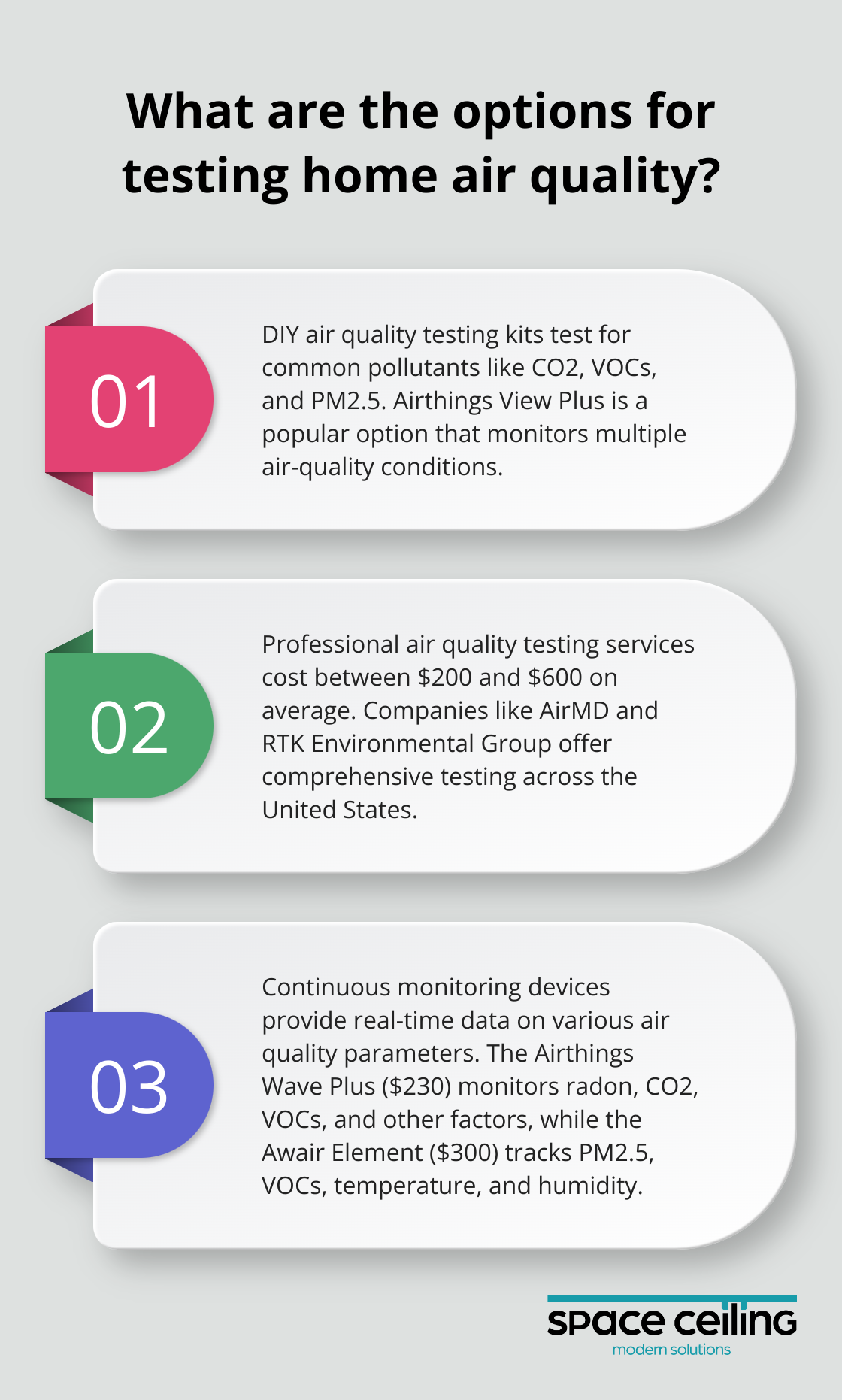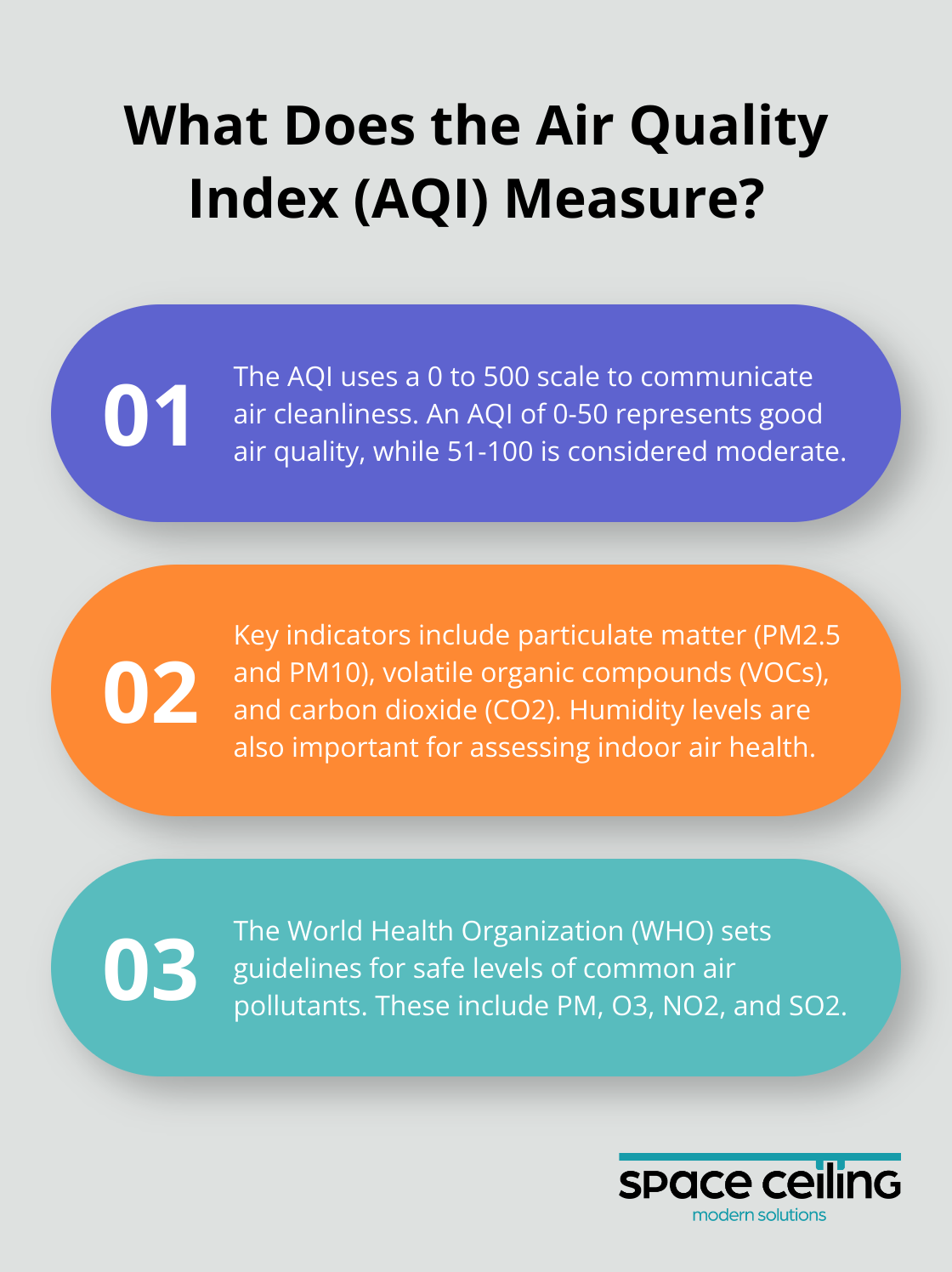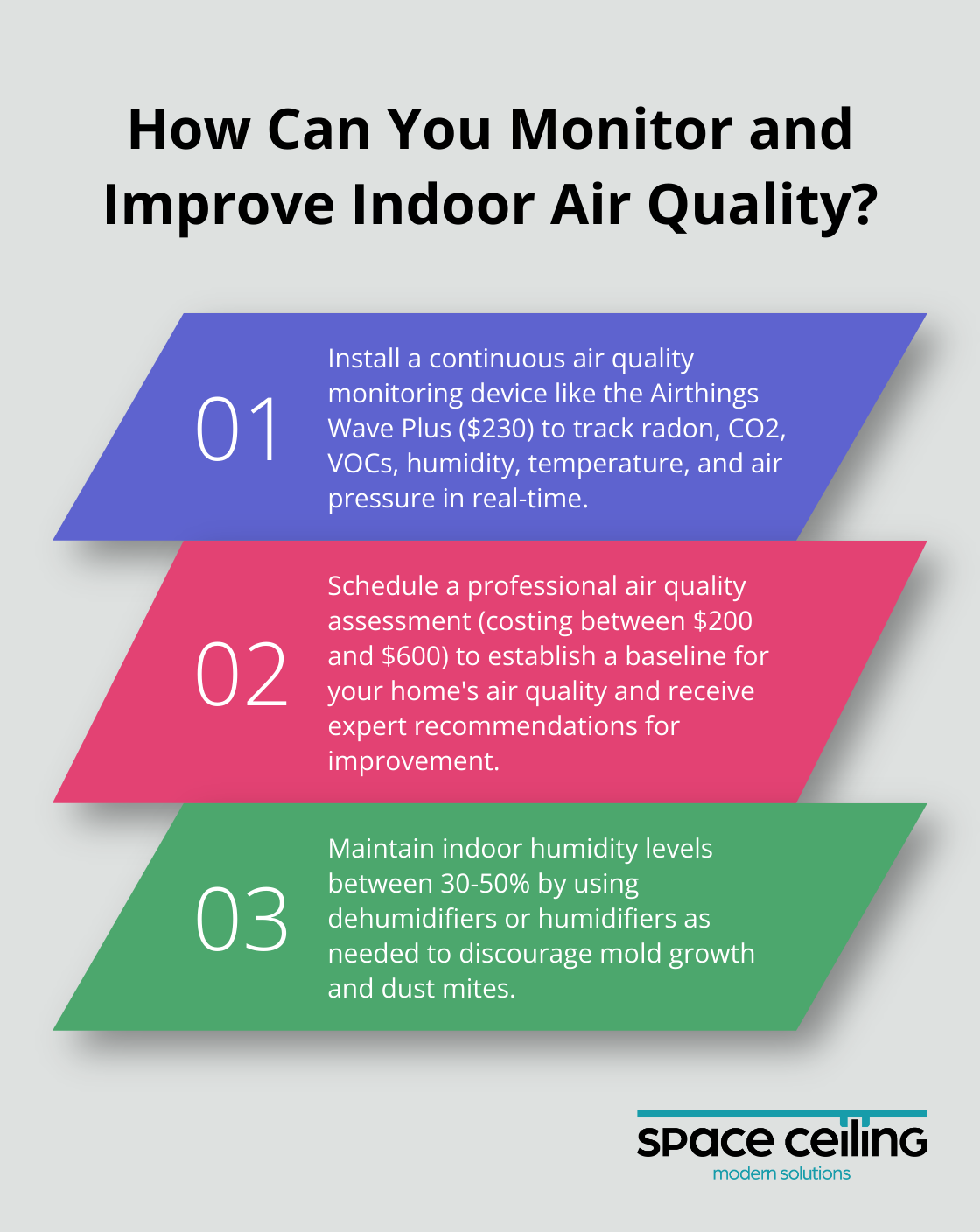At Space Ceiling, we understand the importance of clean air in your home. Indoor air quality can significantly impact your health and well-being.
That’s why we’ve created this guide on how to test air quality in your home, including information on air quality testers for homes.
Our stretch ceilings are antistatic and easy to clean, contributing to better air quality, but testing is still crucial for a comprehensive understanding of your indoor environment.
What’s Lurking in Your Indoor Air?
The Invisible Threats
Your home’s air can harbor a variety of pollutants. Common culprits include volatile organic compounds (VOCs) from paints and cleaning products, particulate matter from cooking and outdoor pollution, and biological contaminants like mold spores and dust mites. The air exchange rate with the outdoors is an important factor in determining indoor air pollutant concentrations, which underscores the need for awareness and action.
Health Impacts You Can’t Ignore
Poor indoor air quality isn’t just about comfort; it’s a serious health concern. Short-term exposure to pollutants can cause irritation of the eyes, nose, and throat, headaches, and fatigue. Long-term exposure is even more alarming. The World Health Organization links household air pollution to noncommunicable diseases including stroke, ischaemic heart disease, and chronic obstructive pulmonary disease. Children, elderly, and those with pre-existing conditions face particular risks.
Factors Shaping Your Air Quality
Several elements influence the air quality in your home. Ventilation plays a key role; inadequate air circulation can trap pollutants indoors. Humidity levels are another important factor. The EPA recommends maintaining indoor humidity between 30 and 50 percent to discourage mold growth and dust mites. Building materials and furnishings can also emit pollutants, especially when new.
Taking Control of Your Air
Understanding these factors empowers you to take action. Regular cleaning, proper ventilation, and using low-VOC products can significantly improve your indoor air quality. For those concerned about existing ceiling materials, stretch ceilings offer a solution. They’re not only aesthetically pleasing but also antibacterial and eco-friendly, contributing to a healthier indoor environment without the need for extensive renovations.
The Next Step: Testing Your Air
Now that you understand the potential threats lurking in your indoor air, it’s time to take a closer look at how you can test and monitor your home’s air quality. In the next section, we’ll explore various methods for testing air quality at home, from DIY kits to professional services and continuous monitoring devices.

How to Test Your Home’s Air Quality
DIY Air Quality Testing Kits
At Space Ceiling, we believe homeowners should have practical knowledge about their indoor environment. DIY air quality testing kits offer an immediate way to assess your air. These kits typically test for common pollutants like CO2, VOCs, PM2.5 (fine particles), radon, and humidity. However, these kits provide only a snapshot of your air quality and may not offer the comprehensive analysis that professional testing does.

Popular options include the Airthings View Plus, which monitors more air-quality conditions than any other device we’ve tested.
Professional Air Quality Testing Services
For a thorough assessment, professional air quality testing services provide the most comprehensive results. These experts use sophisticated equipment to measure a wide range of pollutants and provide detailed analysis of your indoor air.
Professional air quality testing costs between $200 and $600 on average (depending on home size and testing extent). Companies like AirMD and RTK Environmental Group offer comprehensive testing services across the United States.
We recommend professional testing if you suspect serious issues like mold infestation or if you experience unexplained health symptoms. These services can detect problems that DIY kits might miss and provide actionable recommendations for improvement.
Continuous Air Quality Monitoring Devices
Continuous monitoring devices offer an excellent investment for ongoing awareness of your indoor air quality. These smart devices provide real-time data on various air quality parameters, allowing you to track changes over time and take immediate action when necessary.
The Airthings Wave Plus ($230) monitors radon, CO2, VOCs, humidity, temperature, and air pressure. For those focused on particulate matter, the Awair Element ($300) tracks PM2.5, VOCs, temperature, and humidity.
These devices often come with smartphone apps that provide alerts and trends, making it easy to maintain optimal air quality in your home. While they require an upfront investment, they offer long-term value by helping you maintain a healthier living environment.
Combining Testing Methods for Comprehensive Results
We at Space Ceiling recommend a multi-faceted approach to indoor air quality testing. Start with a professional assessment to establish a baseline, use continuous monitoring for day-to-day awareness, and perform periodic DIY tests to check for specific pollutants. This strategy ensures you always breathe the cleanest air possible in your home.
Now that you understand how to test your home’s air quality, let’s explore how to interpret these test results and what they mean for your health and home environment.
What Do Air Quality Test Results Mean?
Decoding Air Quality Indexes
The Air Quality Index (AQI) provides a standardized system to communicate air cleanliness. The Environmental Protection Agency (EPA) uses a 0 to 500 scale, where lower numbers indicate better air quality. An AQI of 0-50 represents good air quality with little or no risk, while readings of 51-100 are considered moderate with some potential health concerns for sensitive groups.

When you interpret your home’s air quality results, focus on key indicators such as particulate matter (PM2.5 and PM10), volatile organic compounds (VOCs), carbon dioxide (CO2), and humidity levels. These factors paint a comprehensive picture of your indoor air health.
Comparing Results to Health Standards
The World Health Organization (WHO) sets guidelines for safe levels of various pollutants. The WHO Air quality guidelines recommend levels and interim targets for common air pollutants: PM, O3, NO2, and SO2.
Your test results that exceed these standards require immediate action. You might need to improve ventilation, remove pollutant sources, or invest in air purification systems (such as HEPA filters or activated carbon filters).
Identifying Problem Areas in Your Home
Air quality often varies significantly between rooms. Pay attention to areas with poor ventilation, high humidity, or known pollutant sources. Kitchens and bathrooms typically have higher humidity levels, while basements may contain elevated radon concentrations.
Consistently poor results in specific areas call for targeted solutions. You can use dehumidifiers to manage moisture in damp basements, while proper ventilation in kitchens reduces cooking-related pollutants.
Taking Action Based on Results
High PM2.5 levels might indicate a need for better air filtration or reduced outdoor air infiltration. Elevated VOC readings could prompt you to identify and remove sources of these compounds (e.g., certain paints, cleaning products, or new furniture).
CO2 levels above 1000 ppm suggest inadequate ventilation. You can address this by increasing natural airflow or installing mechanical ventilation systems.
Humidity levels outside the 30-50% range can lead to mold growth or increased dust mite activity. Use humidifiers or dehumidifiers as needed to maintain optimal levels.
Continuous Monitoring for Long-term Health
Air quality testing provides a snapshot of your indoor environment. However, conditions can change rapidly due to various factors (seasonal changes, new furnishings, etc.). Continuous monitoring devices can provide users with a simple and quick way to determine levels of some air pollutants and/or environmental parameters, allowing you to track trends and make immediate adjustments when necessary.
Final Thoughts
Regular air quality testing protects your health and well-being. We at Space Ceiling understand the importance of clean air in your living spaces. Our stretch ceilings offer an antistatic and easy-to-clean solution that contributes to better air quality.

Improve indoor air quality with proper ventilation, air purifiers, and reduced pollutant sources. Regular cleaning and maintenance of HVAC systems also play a significant role. Air quality testers for homes provide valuable insights into your indoor environment.
The long-term benefits of good air quality include reduced risk of respiratory issues and allergies. Better air quality can result in increased productivity and improved sleep. You can create a cleaner, healthier indoor environment with the right tools, knowledge, and solutions like our stretch ceilings.



